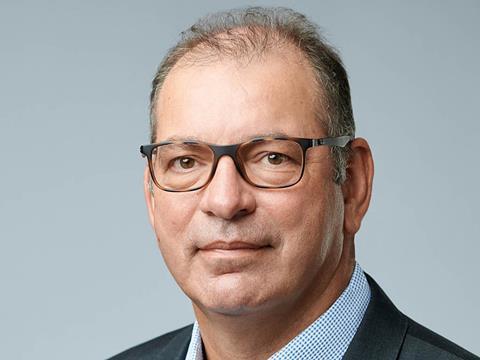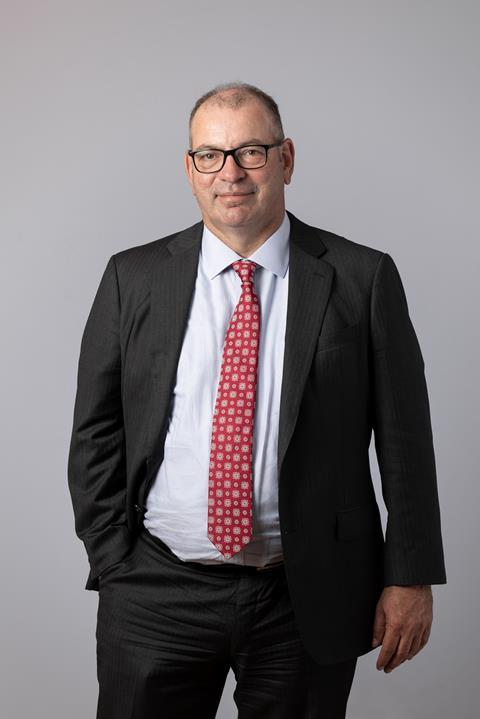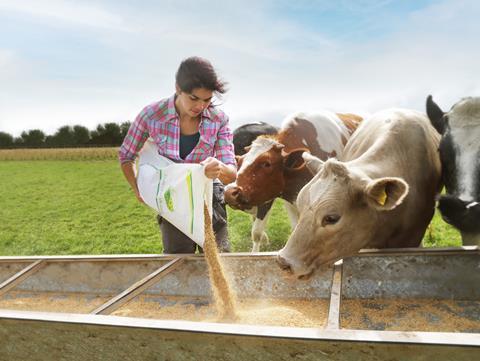
“I look forward to taking on the challenge of developing BillerudKorsnäs to reach its full potential,” said Christoph Michalski, CEO of Billerud, when taking up the post in the summer of 2020. Lots has happened since he got started – the major acquisition of Verso in the United States is one example, and the recently announced partnership with Viken Skog in Norway another. Sitting down with Bo Wallteg – editor-in-chief at nord emballage (where this article originally appeared) – over lunch at HK, Michalski elaborated on his thoughts on the US and Norway and what awaits around the corner.
In October, BillerudKorsnäs became just Billerud, changing its name to cater to the international market. The new name is used throughout the rest of this text.

Christoph Michalski was previously CEO of Vinda International Holding, a leading Asian producer of high-quality and innovative tissue and hygiene products that is listed on the Hong Kong Stock Exchange. He has also held a number of senior positions in the SCA Group. When taking over, he felt things were a bit stagnant in the company.
“I felt that the strategy lacked clarity. When that’s the case, an organisation usually continues to perform, but not much development takes place; nothing new or innovative is presented. At the same time, we were, and are, in a situation where our market is changing rapidly.
“I received a very open brief from the Board when I started, and it was clear that they wanted more. They wanted to grow the company, do something different, and, not least, grow internationally. It was a very clear statement from them.”
A clear strategy plan was drawn up, aimed at achieving profitable and sustainable sales growth until 2030. It established, among other things, that Europe would continue to be the primary market, but that new business opportunities would be explored, specifically for a board in the US. That goal has now been met. Other things that were decided included achieving high production efficiency and increasing production capacity in existing units.
“We decided that we will have sustainable growth in packaging materials, and we are setting out on a journey to become a major packaging materials manufacturer,” Michalski said.
“We have become better at understanding the demands of our customers’ customers and seeing where we can really contribute, what the market wants, and looking at the possibilities of contributing in the near future using the machine park we have.
“By that, I mean that we focus on what we do best, which is making packaging materials from virgin fibre. There are so many advantages to our material, not least in the ongoing discussion about fibre vs. plastic. Plastic does have a role to play, but in many applications, our fibre is not only more sustainable, but also offers higher quality in other respects, and we need to be there and deliver the right material.
“A third thing to look at is where we get the raw materials from. Once we figure this out, we have removed many limitations and can start looking at the outside world with other eyes.”
United States
In the strategy plan, the outside world became, more specifically, the United States. How would they be able to expand in this giant market? They were already there, supplying 90,000 tonnes annually from the mills in Sweden. Now they wanted to grow considerably through an acquisition, and when making an analysis of the market, they found a number of candidates on the list, all with their pros and cons.
They found Verso Corporation, a leading manufacturer in North America of graphic paper, specialty paper, packaging paper, and pulp, with three mills and about 1,700 employees. Billerud acquired the business for $825 million.
“What happened was that Atlas Holding, which owned just over 9% of Verso Corporation, made an offer to buy the entire company. A door opened up for us; we saw the opportunities, and initiated talks with Verso,” Michalski said.
“Graphic paper is not what we should be producing, considering our strategic focus on packaging materials, but we saw the potential for a change in production. The due diligence process became largely about how we would convert one of their production lines into a board line, but obviously also about the availability of fibre.
“We produced the right conditions for really being able to discuss a deal.”
Today, Michalski is pleasantly surprised by how strongly the graphic paper market has developed in the United States in the past year.
“It’s said that good luck comes to those who work hard, and this is a great example of that. Our business plan included making changes as quickly as possible, but we didn’t expect such a positive development in graphic paper.
“The strong market for graphic paper means that we now have much greater flexibility in implementing our strategy. We will most likely convert the other line as well, but it may take longer than planned. We initially said 2029, but if the trend in graphic paper continues, it may very well be a few more years.”
A KM7 twin
In 2025, one of the graphic paper lines will be converted to board production. The intention is to have a US twin to the KM7 at Gruvön in Sweden. The KM7 is a giant board machine with an annual capacity of 550,000 tonnes. Billerud now has three years to get everything in place. The combined investments for both lines total approximately nine billion SEK.
“In the first half of next year, we’ll know exactly what will be required for this conversion. After that, it will very much depend on our suppliers – how quickly they can deliver,” Michalski said.
“A good thing about the US is that they always think and build big. This means there is no problem making room space-wise. We don’t need to build a new unit, with all the civilian work that goes into that.”
Raw materials
“The Swedish board maintains a high quality, thanks to our long-fibre wood raw material. The same type of forest cannot be found in the US, but that won’t affect production. Maple will be the main raw material, and Billerud has done extensive testing of the fibre, which works very well. The structure of the fibre is fairly similar to that of Swedish wood, the climate is similar, and the forest is slow growing.

“In fact, the quality of the material will continue to be just as high. Converters will not notice any difference in the material.
“One advantage is that the demand for the raw material has decreased on the American market. Many newspapers have disappeared, and recycled fibre is used for tissue. This means that the prices of raw material are highly favourable, around 30% below the prices in Sweden.
“In Europe, the competition for firewood as raw material is much greater.”
According to Michalski, the current debate surrounding the forest is too polarised, with both sides using their own experts as instruments.
“The Swedish forest today is basically well managed. We are constantly developing sustainable forestry to protect biodiversity. In order to cope with the climate challenges, fossil materials must be replaced with renewable materials from the forest.”
In the coming years, Billerud will work to build the customer relationships needed before taking the new machine into use. The intention is to deliver the message that they are the most sustainable board manufacturer in North America. Billerud as a company is well known among converters, and many are looking for material suppliers who are not part of the competition. At the same time, they need to get converters to start using more folding box board (FBB). In Europe, 90% of all board is FBB, the rest is solid bleached sulphate (SBS). In the US, it’s more or less the other way around.
“We’re offering an excellent material, and we know that FBB is regarded positively among converters. Should it not fully succeed, we can send material to Europe that will have the same landed price as material made in Sweden.”
Being close is key
The American market is big – very big. If Billerud establishes two lines, they will still only have a market share of less than ten percent. The competitive impact in terms of market share is thus limited; however, they have high hopes for the competitiveness of their material. Sustainability promises from the major brand owners and retail chains are also a factor when assessing the opportunities in the market.
“Being close to the market is becoming increasingly important. Ten years ago, we were talking about a global economy and that it didn’t matter where production was located, but everything is different now, and everyone is aware of the issues in the supply chains. Everyone wants to minimise the risks and is moving from global to more regional networks.
“Also interesting for us is that while there are no major investments in packaging in the US, the growth that is taking place needs to be managed. In other words, we are not a direct threat to the US players.
“When we start up the new machine, we will make sure that we have sold volumes for at least half of the capacity.”
Norway
If we continue to look west, but a little closer, we end up in Norway, where Billerud recently entered into a partnership with Viken Skog and the mill in Follum outside Hønefoss. Together, they will produce bleached chemi-thermomechanical pulp (BCTMP) for the production of carton board at Billerud. The mill will be made state-of-the-art, with a major focus on environmental aspects.
“We will explore the possibilities of bioenergy CCS and biogas production, which I find highly interesting. My vision is for us to become a carbon-negative facility in the next ten years. We will then have the advantage of having renewable materials while also taking care of our biogenic carbon emissions.
“We believe there will be financial incentives that will make it profitable to capture carbon dioxide. Today, this is associated with major investment costs, but if we can get to a point where we get as much paid to capture it as the capture costs, we won’t hesitate to do this in all mills.
“In addition to investments in the capture itself, a functioning infrastructure is required to take care of and store what is captured. These are investments that don’t fall on just one company – everyone must help, both government agencies and industries.
“In Norway, we now want to investigate whether this can be done in a profitable and productive way. I think, in the future, we will get paid to capture carbon dioxide. Instead of paying a hundred dollars to emit a tonne, we can make as much in income. It’s only a logical consequence of the discussions. We will capture the carbon and get the credits. We will achieve negative carbon production.”
Michalski describes the partnership with Viken Skog as a “marriage made in heaven”. The location is ideal, near the Swedish border and the Gruvön mill, as well as near much of the infrastructure needed to establish the production line. Here they have found a perfect supplier of the fibre required. A project feasibility study is now underway. It will be completed in the first six months of 2023. At the beginning of August, Norway’s Prime Minister, Jonas Gahr Støre, and the Minister of Commerce, Jan Christian Vestre, paid a visit to the mill together with Christoph Michalski. There is a strong interest in projects of this kind in Norway.
Electricity, war, and business cycles
We concluded our lunch with a few comments on the current market situation, with the war in Ukraine, soaring electricity prices, and business cycles. When it comes to electricity, Michalski is not exactly concerned. Billerud is well-positioned cost-wise for the next two years and, by then, he thinks that prices will be back at normal levels again. In addition, they are quite self-sufficient in terms of electricity. For fibre mills, this is not a major issue.
“From an industrial perspective, we are better equipped for today’s problems than many of our competitors, especially when looking at those in Europe. If you are currently forced to buy electricity, fibre raw material, and gas, you’re in a challenging situation.
“Another positive for us is that we are now, through the US, one-third dollar-based. The market is good and the energy discussion there is a very different one. The brutal war in Ukraine is a tragedy for the Ukrainian people, but we only had a small percentage of our business in the country that we stopped when the sanctions came into effect.”
So, not much seems to worry Michalski, although there is one thing, which is troublesome enough: a possible depression next year, as a result of war, electricity prices, and inflation.
“This has me concerned for two reasons – one, it may affect the demand from brand owners, although I see a volume towards consumers that is relatively stable. Secondly, the constantly increasing prices of inputs, not least chemicals. Right now, we are good at passing on the costs to our customers, who, in turn, pass them on to theirs, but if consumption goes down in society, it can have a strong impact.
“Generally speaking, I find that Billerud has no problems, especially not in comparison with many other companies in Europe.

“We help our customers to reduce their climate footprint from both their primary and secondary packaging. For us, product superiority is key, and the impressive strength of our paper allows customers to use less packaging, save on costs, and reduce their carbon footprint. One example is our CrownBoard product family for luxury segments such as confectionery and cosmetics. With our Performance White Barrier, we remove the plastic in industrial bags. We also support our customers in switching from plastic or other conventional materials to paper.”
That’s about all we had time to cover over lunch. Billerud is certainly on the offensive, and from employees, we hear that lots of very positive things have happened in the Group over the past few years, both externally and internally. More is surely to be expected.












No comments yet